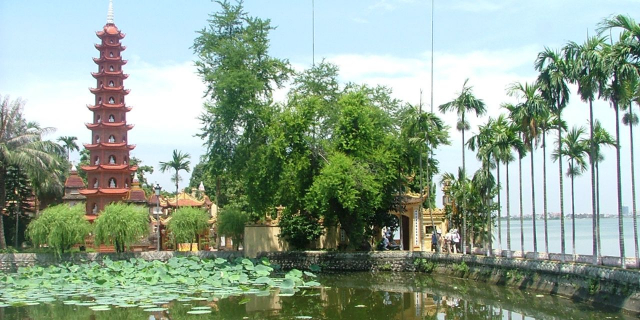Văn Miếu – Quốc Tử Giám
( Temple of Literature, Hanoi )
Văn Miếu (Vietnamese: Văn Miếu, chữ Hán: 文廟), literally translated as Temple of Literature (although a more accurate name should be Temple of Confucius, as Văn refers to Confucius), is a temple dedicated to Confucius in Hanoi, northern Vietnam. The temple was built in 1070 at the time of Emperor Lý Thánh Tông, and it hosted the Imperial Academy (Quốc Tử Giám, 國子監), Vietnam's first national university, from 1076 to 1779.
The Văn Miếu is one of several temples in Vietnam which is dedicated to Confucius, sages, and scholars. The temple is located to the south of the Imperial Citadel of Thăng Long. The various pavilions, halls, statues, and stelae of doctors are places where offering ceremonies, study sessions, and the strict exams of the Đại Việt took place. The temple is featured on the back of the 100,000 Vietnamese đồng banknote. Just before the Tết Vietnamese...Read more
Văn Miếu (Vietnamese: Văn Miếu, chữ Hán: 文廟), literally translated as Temple of Literature (although a more accurate name should be Temple of Confucius, as Văn refers to Confucius), is a temple dedicated to Confucius in Hanoi, northern Vietnam. The temple was built in 1070 at the time of Emperor Lý Thánh Tông, and it hosted the Imperial Academy (Quốc Tử Giám, 國子監), Vietnam's first national university, from 1076 to 1779.
The Văn Miếu is one of several temples in Vietnam which is dedicated to Confucius, sages, and scholars. The temple is located to the south of the Imperial Citadel of Thăng Long. The various pavilions, halls, statues, and stelae of doctors are places where offering ceremonies, study sessions, and the strict exams of the Đại Việt took place. The temple is featured on the back of the 100,000 Vietnamese đồng banknote. Just before the Tết Vietnamese New Year celebration, calligraphists will assemble outside the temple and write wishes in Chữ Hán. The art works are given away as gifts or are used as home decorations for special occasions.
 Thiên Quang ("Heaven Light") Well, also known as Literature Well
Thiên Quang ("Heaven Light") Well, also known as Literature WellThe Văn Miếu was built in 1070 and was reconstructed during the Trần dynasty (1225–1400) and in the subsequent dynasties. For nearly two centuries, despite wars and disasters, the temple has preserved ancient architectural styles of many dynasties as well as precious relics. Major restorations have taken place in 1920, 1954 and 2000.[1]
"In the autumn of the year Canh Tuất, the second year of Thần Vũ (1070), in the 8th lunar month, during the reign of King Lý Thánh Tông, the Văn Miếu was built. The statues of Confucius, his four best disciples: Yan Hui (Nhan Hồi), Zengzi (Tăng Tử), Zisi (Tử Tư), and Mencius (Mạnh Tử), as well as the Duke of Zhou (Chu Công), were carved and 72 other statues of Confucian scholars were painted. Ceremonies were dedicated to them in each of the four seasons. The Crown Princes studied here."[2]In 1076, Vietnam's first university, the "Quốc Tử Giám" or Imperial Academy, was established within the temple during the reign of Lý Nhân Tông to educate Vietnam's bureaucrats, nobles, royalty, and other members of the elite. The university remained open from 1076 to 1779. In 1802, the Nguyễn dynasty's monarchs founded the Huế capital where they established a new imperial academy. The academy at the Hanoi temple lost its prominence and became a school of the Hoài Đức District.
Under the French protectorate, the Văn Miếu - Quốc Tử Giám was registered as a Monument historique in 1906. During the period of 1945–1954, the French demolished parts of the temple to make additional room for the Saint Paul Hospital since hospital capacity was full during times of war. Campaigns of restoration were pursued in 1920 and 1947 under the responsibility of École française d'Extrême-Orient (French School of the Far East).[3]
 A military mandarin, a provincial chief and a prefect in solemn audience costume at the Văn Miếu temple in 1915, Autochrome by Léon Busy for The Archives of the Planet
A military mandarin, a provincial chief and a prefect in solemn audience costume at the Văn Miếu temple in 1915, Autochrome by Léon Busy for The Archives of the Planet



























![[Tycho] - CC BY-SA 3.0](/sites/default/files/styles/640x320/public/pla/images/2020-12/1280px-H%C3%B2a_B%C3%ACnh_Province%2C_Kim_B%C3%B4i_District.jpg?h=19cfe918&itok=VDjAzlTZ)







Add new comment